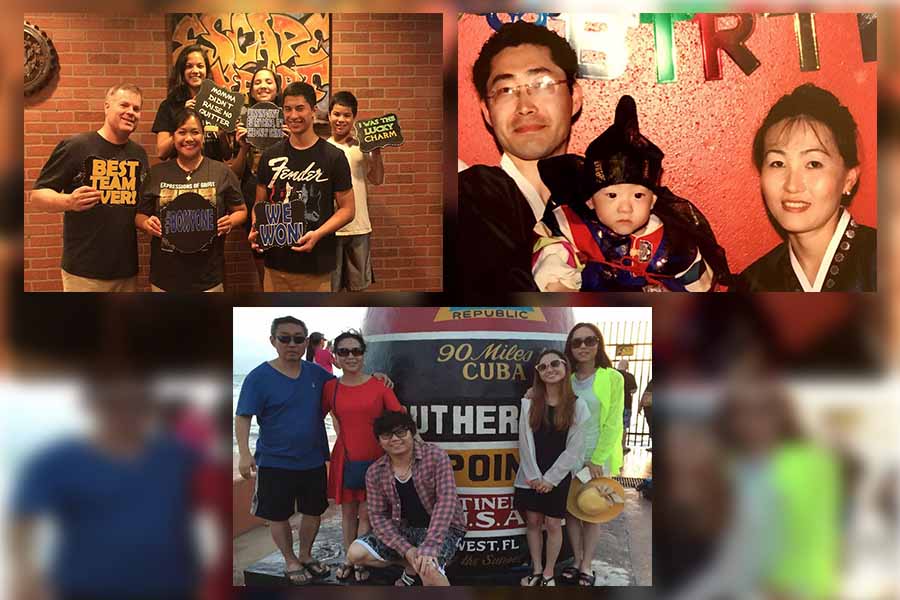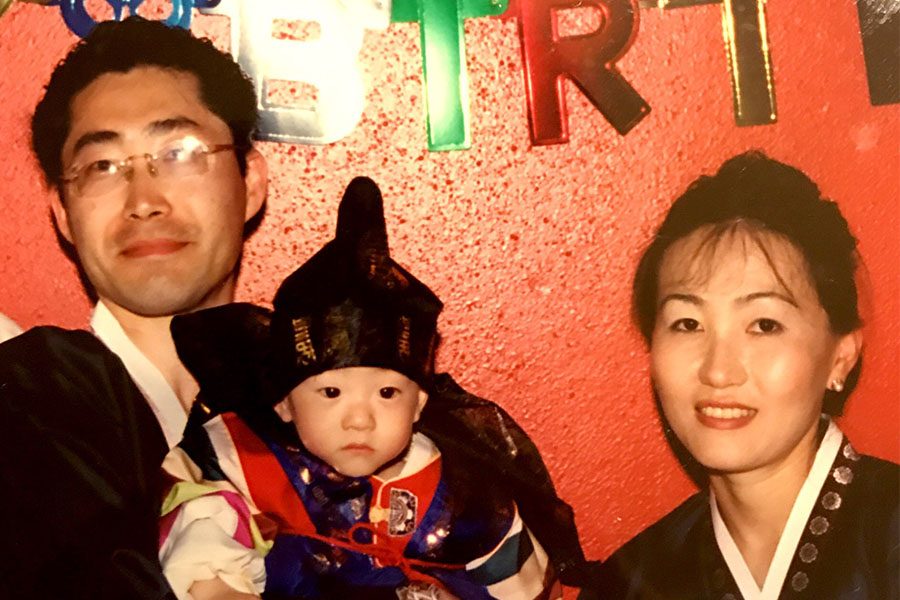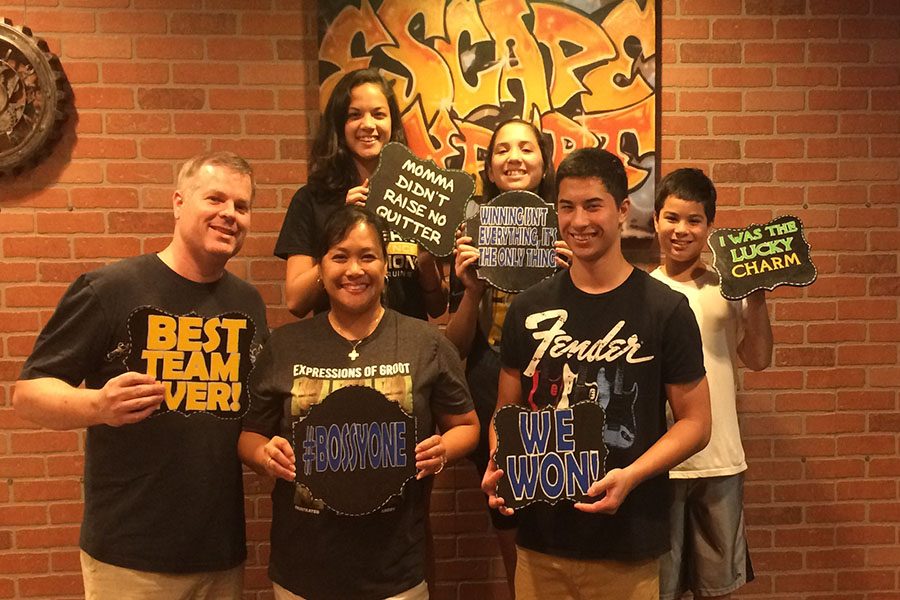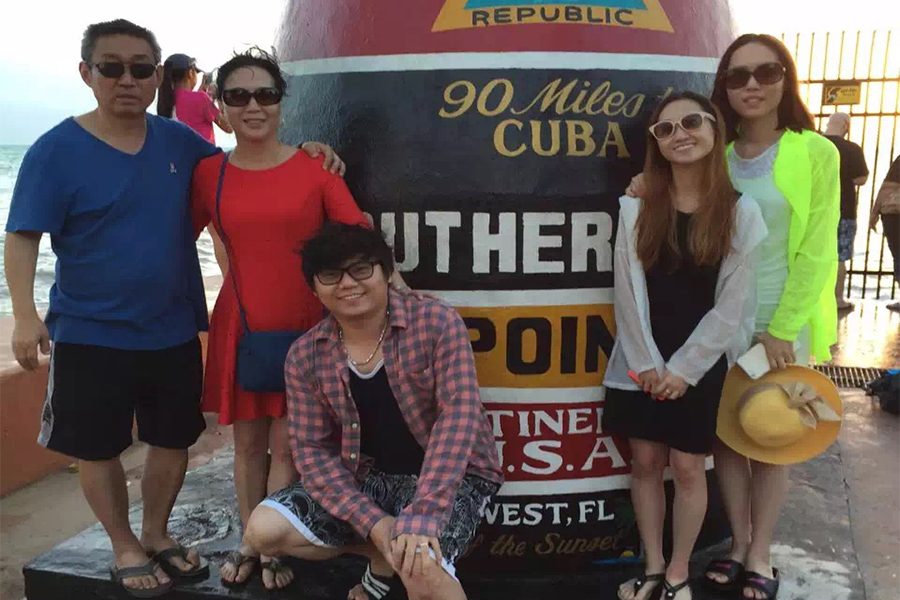Faces of Frisco: Being East and Southeast Asian
April 27, 2018
East and Southeastern Asia includes countries such as China, Japan, North Korea, South Korea, Mongolia, the Philippines, Vietnam, and many more. Here on campus, Asians make up 30 percent of the student body. In a continuing series taking a look at the demographics of Frisco, Wingspan takes a look at three people on campus that identify as an East or Southeast Asian to find out what it means to be Asian in Frisco.
Bryan at age one pictured with his father Sokho and mother Young Ryu.
Bryan Kim
Although there are just under 900 households in Frisco who primarily speak and identify with the Korean culture, freshman Bryan Kim believes being Korean in Frisco gives him the ability to connect with others of the same heritage who also live in his community.
“Being in Frisco helps me meet others with similar ethnic backgrounds as me such as at church where there are some of my best friends,” Kim said.
In addition to connecting with others who have a similar heritage in weekly activities, there are various places in the Dallas-Fort Worth area that allow Kim to further interact with his culture.
“There are many places in DFW to get Korean food and ingredients, such as the H Mart, a Korean marketplace with two locations, one in Plano and one in Carrollton,” Kim said. “Another would be in Koreatown [near Dallas] with streets filled with Korean restaurants.”
Along with Korean food being implemented into the culture of DFW, K-pop music has become more and more popular in the United States in recent years.
“I feel like the more albums that Kpop groups are dropping, the growing popularity they receive,” Kim said. “K-pop has definitely become a lot bigger over the years and due to this popularity, I get several classmates coming to ask if I could teach them [Korean] or any other aspects of the culture associated with it.”
Even though Kim lives almost 7,000 miles away from most of his family, he still finds ways to communicate with his relatives in Seoul, South Korea.
“My close family is the only family living in the U.S.,” Kim said. “I’ve visited South Korea a few times, but not very often and instead usually contact them through video chatting or texting.”
Although Kim and his family live in the United States, they still practice elements of the Korean culture through certain holidays and home-cooked foods.
“We express our culture through eating Korean food on a weekly basis and participating in Korean traditions and holidays from time to time,” Kim said. “One example would be eating a stew called ‘meeyukgook’ on birthdays and calling relatives on Lunar New Year’s.”
Kim’s heritage can also be seen through the origin of his last name, as well as his mother’s maiden last name.
“My dad’s last name is Kim, the most common last name among the South Korean population,” Kim said. “My mom’s last name is Ryu, which derived from the last name ‘Yoo.’”
Along with having one of the most common Korean last names, Kim is fluent in Korean as well as English.
“I can read and write in Korean in order to communicate with others in Korea or those who speak it and also help my mom out with understanding some stuff,” Kim said. “There aren’t really any drawbacks except for me getting some words confused between English and Korean.”
For Kim, being Korean comes with not only knowing another language, but also hearing stereotypes about his culture.
“One [stereotype] would be that all Koreans eat dogs,” Kim said. “Never have I met another Korean who has eaten nor thought of eating a dog due to morals and just the fact of why would you eat that if there’s so much more to choose from.”
Not only does Kim and his family hear racial assumptions about their culture, his dad Sokho Kim has also experienced being treated differently in the workplace, even though it is unconstitutional via the Equal Employment Opportunity Commission.
“We are not supposed to be treated differently because of Equal Opportunity act at workplaces and academic institutions, however, occasionally we encounter such obstacles,” Sokho said. “We need to understand and educate ourselves over the benefit of diversity and recognize the difference as we might be doing the same thing to others.”
While Kim’s family may go through a few obstacles, Sokho believes that there are greater educational opportunities in the U.S. for his son compared to South Korea.
“We hoped that my child could get better opportunity at school with a more creative and open minded environment, which can lead to developed skills and identifying individual potential,” Sokho said. “We believe that this is the major difference between the education system in U.S. and Korea.”
Alexandra (top left) pictured with her sister Gabby, little brother Todd (top left to right), father Todd, mother Leizl, and older brother AJ (bottom left to right).
Alexandra Stiles
For freshman Alexandra Stiles, her Filipino culture has had the most influence on her life, despite the fact that she is also of Spanish, Chinese, and Caucasian descent.
“My mom’s family is originally from the Philippines, Spain and China but her parents were born and raised in the Philippines,” Stiles said.
With her mixed heritage, Stiles says acceptance isn’t usually a problem.
“Most people in Frisco in 2018 don’t care that I am Filipino and everyone usually treats me as an equal,” Stiles said. “But some do make assumptions, saying I look Mexican, which frustrates me because they don’t even know me.”
Along with being mistaken as Mexican, Stiles has experienced stereotyping because of her Filipino heritage.
“There are several Filipino stereotypes that I have grown up with in the Frisco area,” Stiles said. “We’re really loud, love rice, have pictures of the Last Supper hanging in our dining room, and are always late.”
Living 8,222 miles from her ancestral homeland, Stiles and her family still take part in Filipino cultural practices, including cooking traditional foods.
“Every holiday we come together to celebrate, bringing traditional foods like lumpia, cheese puto, pancit, and a lot more,” Stiles said.
While Stiles’ family celebrates and eats Filipino cuisine in the states, many members of Stiles family still live in the Philippines, with her mother Leizl’s parents being born and raised the country
“Growing up with Filipino parents gave me so many different life experiences compared to my friends while growing up,” Leizl said. “My mom often speaks Tagalog and tries to teach me.”
While Leizl’s culture differs from that of her peers, it doesn’t affect how she is treated.
“I have never been treated much differently than other people because of my race or denied any privileges or jobs,” Leizl said. “My Filipino heritage will always be a part of me and I have never regretted [practicing my culture].”
With her mother being so proud of her family’s Filipino heritage and some of her family still living in the Philippines, Stiles finds it important to learn more about the history of her ancestral homeland.
“We do still have family living in the Philippines but I probably won’t ever visit them,” Stiles said. “Although I do think it’s important for me to learn more about the history and landscape of the country that I come from as I find it a fascinating and beautiful place.”
Lisa Cai (second from the right) poses with family.
Lisa Cai
As the country with the largest population on earth, China is home to 1.37 billion people along with speakers of Mandarin, Wú, Cantonese, Southern Min, Jìnyǔ, Hunanese languages and dozens more.
Although she wasn’t born there, junior Lisa Cai identifies herself as a native as both her parents were there and she was raised with the same cultural beliefs of the Chinese.
“I was born in Kansas and I moved to China when I was 2 with my sister and my dad,” Cai said. “We moved back to the U.S when I was in the second grade because my mom had a store here in the U.S and she wasn’t going to move away from it, along with the fact that the schools were better here than in China at the time.”
Despite not being fluent in the English language when she returned, Cai pursued to adapt to her new environment through her strong personality.
“When we moved back I didn’t know any english so it was a little hard in the beginning,” said Cai. “But apparently my mom said that I was really eager to be in the United States and she really believed in how persistent I was.”
Native to the United States, Cai still suffers judgment through common stereotypes and clichés in Frisco.
“People [in Frisco] often think that because [I’m] Asian I have to be really really smart or that I came from California,” Cai said. “I think that I’m smart, but apparently I’m not ‘Asian smart’.”
At home, Cai and her family enjoy eating native and common Chinese foods as their daily meals.
“We eat Chinese food everyday,” Cai said. “Most commonly we’ll have rice, fish, meat, and vegetables.”
Along with their meals, the Cai family enjoys celebrates Chinese holidays as a way to connect to their heritage.
“When Chinese New Year comes along we always make sure to get together and celebrate as a family,” Cai said. “We also enjoy to celebrate the Lunar New Year.”
Although initially learning English can be difficult, knowing a second language and being familiar with two polar opposite cultures can be benefiting, especially in the academic realm of things.
“I get to be bilingual and learn about my native country and America,” Cai said. “I have more knowledge and understanding of both cultures and topics such as schools, lifestyle, politics, and government and I can use that information in school work and essays.”



